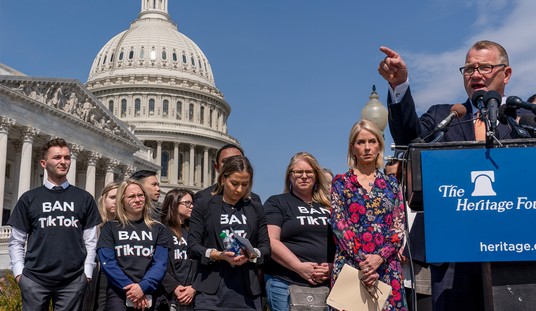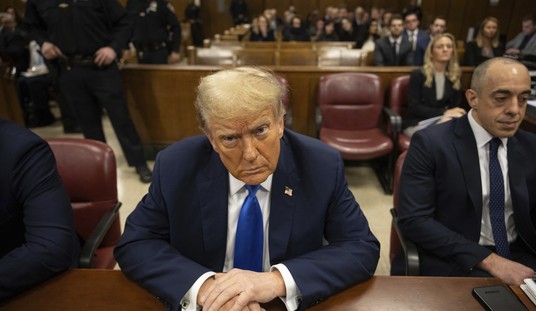Mitch McConnell has great news for all those fretting that Thursday’s exercise of the Reid Option will provide a “slippery slope” that will finish with the total abolition of the filibuster on legislation. Nonsense, the Senate Majority Leader responded yesterday after scheduling the cloture vote on Neil Gorsuch’s confirmation to the Supreme Court. Nobody on either side of the aisle wants that to happen, McConnell says, not even among Senate Republicans who would benefit most from its demise:
https://www.youtube.com/watch?v=sX3Eq05IcbU
McConnell stressed that “there’s no sentiment” among Senate Republicans for overhauling the filibuster on legislation, which typically forces the Senate to compromise and get buy-in from the minority.
“Who would be the biggest beneficiary of that right now? It would be the majority, right?” McConnell told reporters. “There’s not a single senator in the majority who thinks we ought to change the legislative filibuster. Not one.”
When asked whether he would commit to not changing the legislative filibuster under his tenure as majority leader, the Kentucky Republican responded: “Correct.”
McConnell actually presents a good argument for the abolition of the filibuster on all judicial nominations in the very first part of his impromptu press avail yesterday. He accused Chuck Schumer of dreaming up the judicial filibuster after the election of George W. Bush, noting that Democrats didn’t try to block Clarence Thomas with it in 1991 even though they clearly could have done so. Thomas got confirmed in a 52-48 vote in a Democratic-controlled Senate, and Robert Bork lost on a similarly close final floor vote four years earlier. Despite the controversial nature of both nominees, no Democrats thought of using a filibuster to stop them. Using the Reid Option simply returns the Senate to the status quo ante on executive-calendar questions — not a bad argument to make when it comes to convincing traditionalists.
But which traditionalists should we convince, and about which traditions? The filibuster has been held out as the model of what makes the Senate special — the so-called cooling saucer to the teacup of House populism — but that’s a misreading of history, and a misreading of the changing nature of the filibuster. As I write in my column for The Fiscal Times, one major change to the filibuster in the 1960s is the cause of most of the woes that surround it now:
The Senate’s original distinctiveness came from its separate mandate within the Constitution, which had House members elected through popular votes in districts to account for uneven population distribution in the states. In contrast, state governments appointed or elected senators to represent state interests equally. That ended in 1912, when the 17th Amendment forced all states to adopt popular voting for the election of senators, eliminating accountability to the states in favor of the same popular electorate as House members. That change, more than anything contemplated in the 105 years since, changed the nature of the Senate as a deliberative and separate entity.
Five years later, 80 years after the first filibuster, public outrage over Senate obstructionism during wartime forced the Senate to adopt a cloture rule that would allow a supermajority to end debate. Even so, filibusters were generally rare and not terribly successful, as they required continuous actual debate on the Senate floor. Filibusters didn’t just block votes on a particular bill or nominee — they blocked all business in the upper chamber. After a series of filibusters on civil-rights legislation created a freeze in Washington, D.C., the Senate adopted a “two-track” system for debate in 1964, which allowed failed cloture votes on their own as stand-ins for filibusters and Senate business to otherwise proceed normally. Rather than having an average of one filibuster attempt in each Congressional session as it was in the previous decade, the average had grown to 17 per Congress by the mid-1980s — and then 52 in the final congressional session of the George W. Bush administration.
The solution? Either go back to the original filibuster system, or eliminate it altogether:
If traditionalists fear the end of the filibuster on this week’s so-called “nuclear option” vote, then they have a solution. Put an end to the two-track system and force senators into continuous debate to filibuster a bill or a nominee. Make a filibuster the end of all normal business in the Senate until the filibuster is resolved. The cheap nature of the modern filibuster invites abuse, and that leaves only two real options for a system based on majority governance — either get rid of it, or make it so costly that few will abuse it for long.
Either way, Senate Republicans should vote as a bloc to end the cheap use of a procedural ploy to obstruct Judge Gorsuch’s confirmation to the Supreme Court. If that results in the end of the legislative filibuster too, they can either revert it back to its original form, or take comfort in the fact that it was an innovation in the first place — and one with a rather checkered history at that.
To McConnell’s point, the two-track system gave Democrats a painless option to block presidential nominees without having to work at it. My preference would be to keep the filibuster for legislation — there’s too much water under the bridge on nominations now — but only in the original one-track form that forces one party to become total obstructionists to succeed at it. Let’s strip off the masks altogether and force obstructionists into the light, and make them work for it.








Join the conversation as a VIP Member